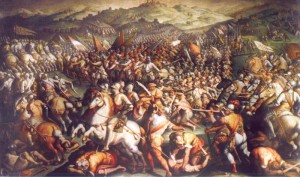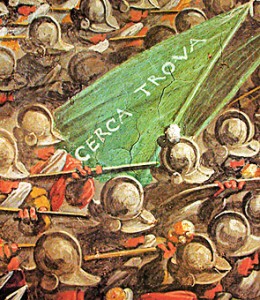
In the 15th century, Florence was the focal point of a cultural rebirth known famously as the Italian Renaissance. Their newfound economic and cultural power, coupled with the strong leadership of Cosimo de Medici of the Medici family, found Florence on the precipice of domination. With Cosimo I de Medici leading the way, Florence embarked on controlling its neighbors either through diplomacy or force, all under the name of the Duchy of Tuscany. There was one city-state remaining in the region that stood a chance against the growing power of the Duchy, and that was Siena. There was also a broader conflict between France and Spain that instigated the fighting. France supported Siena, because it wanted a strong ally on the Italian peninsula, and Spain supported Florence because of its wealth and its control over the majority of Tuscany, which Spain wanted a hand in. On August 2nd 1551, a Florentine militia faced Sienese militia in the Battle of Marciano, the fight for control of the region. With each army reaching about 15,000 in number, the stage was set for a bloody day, but Florence won a sweeping victory, as their superior artillery simply overpowered the men of Siena and their allies. The Sienese suffered many losses in the form of death, wounds, and prisoners, while the Florentines, relatively speaking, did not lose many men. The battle undeniably had a great collective effect on the shaping of both cities well within the grips of the Renaissance. One of the tangible products of this effect plays a very important role in Robert Langdon’s quest in Dan Brown’s Inferno. The day of the battle, as a trophy of sorts, the Florentine soldiers collected over 100 green flags that the Sienese had been given by French royalty as a sign of support. After the battle was over, Cosimo I had Giorgio Vasari paint a large mural commemorating the battle inside a governmental Palace in Florence, the Hall of Five Hundred. Giorgio Vasari’s depiction of the Battle of Marciano hangs in that spot to this day. This painting, one of the best artistic achievements of the Renaissance, provides Langdon and Dr. Siena Brooks (who’s name is not a mere coincidence) with a major clue hidden within the painting. The phrase “cerca trova”, Latin for, “Seek and ye shall find”, can be seen on a green flag (one of the green flags the Florentines had seized) within the painting.

“Cerca trova” is one of the most prominent and important clues Langdon and Brooks come across throughout the novel. It appears in the very first chapter of the book, where a mysterious woman (eventually found to be WHO director Elisabeth Sinskey) appears to Langdon in a dream, reciting the English translation of the term. It later appears as an anagram, CATROVACER, in the first clue Langdon finds. The phrase itself, Seek and Ye Shall Find, is a biblical allusion (Matthew 7:7) that is actually a direct quote from Jesus Christ. That historical and religious connection provides a certain sense of importance, or gravity, to the phrase. Perhaps the reason the phrase “cerca trova” appears on a green flag in Vasari’s famed painting is a very minor allusion to Jesus’ bloodline in the Da Vinci Code. The green flags, a gift of the French, contains one of the only significant biblical references in the novel (of an author who usually creates his plots around controversial religious theory). In the Da Vinci Code, the eventual bloodline of Jesus Christ is believed (proven, within the context of the novel) to have ended up in a French family. Although a quotation of Jesus is a small connection, in the grand scheme of Dan Brown’s Inferno, it is one of the only biblical references Brown makes, which draws much more attention to it, especially considering the amount Brown relies on the Bible and Christianity in few of his other, more well known novels. The connection of “Cerca Trova” to Brown’s novel shows how intertwined Montaperti and Marciano are with both works of literature. Brown’s ability to intricately connect his novel with these important battles in history is perhaps his best feature as an author.